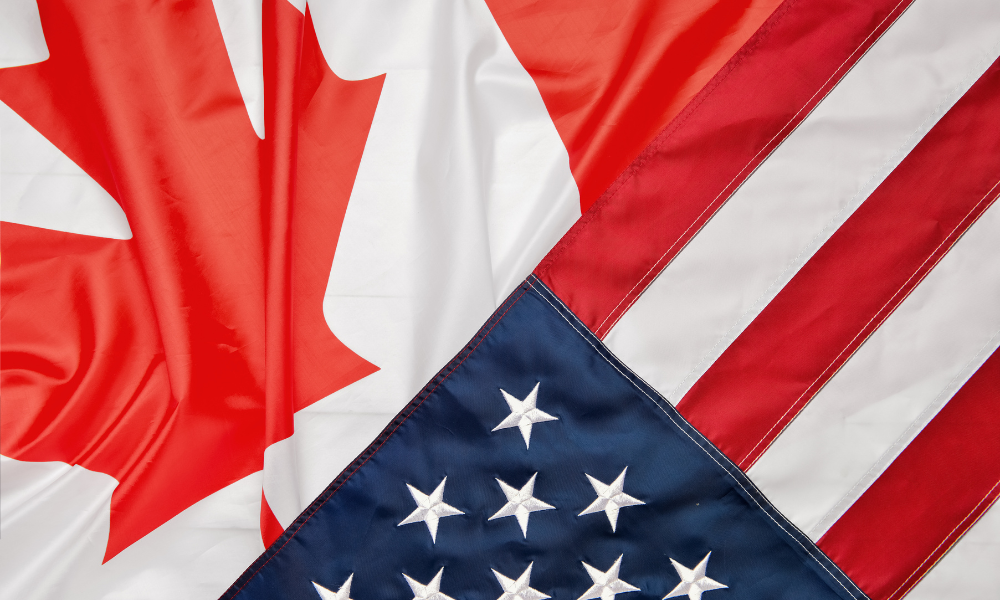- How to move to Canada from US for work
- How to move to Canada from US as investors
- How to move to Canada from US for study
- How to move to Canada from US for family
- Impact of changes on US to Canada immigration
- How to move to Canada from US – steps to citizenship
- How long does it take for a US citizen to immigrate to Canada?
- Just the first step on how to move to Canada from US
Are you looking for ways on how to move to Canada from US? Despite long-standing cultural ties and shared borders, political and economic tensions — including recent tariff disputes — have strained the relationship between the two countries. Even so, US citizens still benefit from relatively streamlined processes when moving to Canada, especially compared with applicants from other countries.
Mastering how to move to Canada from US starts by figuring out the manner of entry. The most obvious ones are through marriage or a committed relationship with a Canadian citizen. Compared with other manners of entry, spousal sponsorship is perhaps the easier approach.
But what about other manners of entry? This is where most of the changes for how to move to Canada from the US is happening.
How to move to Canada from US for work
American citizens who wish to move to Canada from US may choose between federal, territorial, or provincial processes. In a nutshell, these programs are designed to attract talent among US citizens. The government identifies critical areas in the labor market and welcomes immigrants who meet those needs.
There are three primary manners of entry:
- Express Entry through the federal government
- Express entry via the Provincial Nominee Program (PNP)
- Non-express entry
Here’s a quick overview of each one:
|
Express Entry via Federal |
Express entry via PNP |
Non-express entry |
|---|---|---|
|
Application through the federal website |
Application is through the federal website with provincial nomination |
Application through the provincial website |
|
Requirements set by the federal government |
Applicants must meet the requirements of the province and the federal government |
Requirements set by the province or territory |
|
Successful applicant can reside in any province or territory of Canada |
Obtain a nomination from preferred provinces |
Those who migrate to Canada via PNP must reside and work in the province/territory that nominated them |
|
|
Update the express entry profile upon receipt of nomination |
|
Provincial Nominee Program (PNP)
US citizens may use the Provincial Nominee Program (PNP) offered by each Canadian province and territory except Québec. Québec has a separate program like PNP which is the Regular Skilled Worker Program (RSWP).
Provincial nominees under the PNP may apply through the different streams offered by a specific province or territory. This targets certain groups of immigrants, with streams for:
- students
- businesspeople
- skilled workers
- semi-skilled workers
Each stream has its own requirements according to provincial needs.
For interested US citizens, you may apply through the specific website of the province or territory you are trying to move to (called non-Express Entry process) or through the Express Entry process.
For example, Ontario’s PNP is called the Ontario Immigrant Nominee Program (OINP) found on its official website. Applications are mainly done online. For this, we’d recommend reaching out to the best immigration lawyers in Ontario for assistance.
Express Entry Process
American skilled workers may move to Canada from the US through the federal government’s Express Entry. Under the Express Entry Process are three programs to choose from:
- The Canadian Experience Class
- The Federal Skilled Worker Program
- The Federal Skilled Trades Program
Each Program has its specific requirements. In general, a US citizen should have skilled work or skilled trade experience, for a minimum number of years. This should have been acquired during a paid job, which may be part-time or full-time work. If interested, you may apply online through the official website of the Canadian federal government.
Changes in the express entry process
The express entry system used to give points for arranged employment via the Canadian Experience Class. However, recent changes have removed this point system. This change is making it difficult for older applicants to receive invitation to apply for permanent residence in Canada, says immigration lawyer Alejandra Garcia of Langford Law.
She reveals that the government also introduced significant changes to eligibility requirements for Study Permits, Post-Graduation Work Permits, and Work Permits of the spouses of temporary residents. Lower admission targets were also revealed during the 2025-2027 Levels Plan for both temporary and permanent residents.
How to move to Canada from US as investors
The Express System is primarily designed for foreign citizens seeking employment in Canada. But what about the reverse? US citizens planning on moving to Canada from the US may do so as prospective employers. This means they can enter for trade or investment activities.
A helpful law for business entry is the Canada-United States-Mexico Agreement (CUSMA). The CUSMA simplifies certain processes for US and Mexico residents in entering Canada, such as removing the requirement of a Labour Market Impact Assessment (LMIA) for businesspersons. It also removes the requirement for a work permit when a business visitor enters Canada.
Here’s a helpful explainer about CUSMA:
The CUSMA provides for the categories of businesspersons, which have its own eligibility:
- business visitors
- professionals
- intra-company transferees
- traders and investors
How to move to Canada from US with a start-up visa
Prospective investors can use the Start-up Visa Program under the federal government. Under this program, an interested entrepreneur or investor may live in Canada based on their potential to create businesses and generate jobs in the country.
Any US citizen interested in applying for a Start-up Visa must meet these requirements:
-
Have a qualifying business. A qualifying business is one that meets conditions on voting rights and business incorporation
-
Have a letter of support from a designated organization. A designated organization is one that has been approved by the government to invest in or support a possible start-up
-
Meet the language requirements with proficiency in English and/or French
-
Have sufficient settlement money: proof of funds will depend on the size of your family
If you need help with applying for a Start-Up Visa, consult with an immigration lawyer in the province where you plan to start your business. If you’re looking to move to Alberta, for example, speak with one of the best immigration lawyers in Alberta.
How to move to Canada from US for study
You may also move to Canada from the US as an international student, which will open the doors for you to apply for permanent residency and citizenship after graduating. All international students (including US citizens) would need to apply for a student permit to study in Canada.
In applying for a student permit, you need to first acquire an acceptance letter from a designated learning institution (DLI). This is a school or college approved by the government to host international students.
Here’s a video for hopeful international students in 2025:
After graduating from a DLI, US citizens can choose to apply for a Post-Graduation Work Permit (PGWP). This lets you work in the country and could be the first step on moving to Canada from US. The work experience may be used when applying for permanent residency.
PGWPs have their own set of requirements. Even if you graduate from a DLI, that doesn’t automatically mean eligibility for a PGWP. The program or course you graduated from is also a factor in determining eligibility. In some cases, the program may not qualify for a PGWP application, so the student still needs to find another pathway.
How to move to Canada from US for family
Moving to Canada from the US is also possible through spousal sponsorship or family sponsorship. Under Canada’s immigration laws, an eligible sponsor may sponsor their qualified spouse or their family member for permanent residency.
Additionally, the law requires both the sponsor and the sponsored spouse or family member to sign a sponsorship undertaking and a sponsorship agreement. This agreement details the fiscal responsibility of the sponsor with respect to the people being sponsored.
The agreement can be anywhere from three years to 10 years, depending on the relationship. Here’s a clear look at the sponsorship timeline:
|
Relative |
Undertaking starting on approval |
Undertaking for sponsors in Québec |
|---|---|---|
|
Spouse or partner |
3 years |
3 years |
|
Dependent child |
10 years or until the age of 25, whichever comes first |
|
|
Dependent child under 16 years old |
|
At least 10 years or until the age of 18, whichever is longer |
|
Dependent child 16 years old or older |
|
At least 3 years or until age of 25, whichever is longer |
|
Dependent child 22 years old or older |
3 years |
|
|
Parent or grandparent |
20 years |
10 years |
|
Other relatives |
10 years |
10 years |
Impact of changes on US to Canada immigration
US citizens who want to enter Canada as visitors or tourists do not need a Canadian visa. However, if you plan to stay in Canada beyond 6 months, a specific visa may be needed. Unfortunately, the process for acquiring visas for US citizens isn’t as easy as it used to be.
“Temporary residents, including US citizens, are now experiencing greater difficulty and frustration in transitioning from temporary residence to permanent residence in Canada,” says Garcia. This is due to:
- high scores in the Express Entry pool
- long processing times for temporary resident status extensions
- changes to program requirements that are not always easy to find or understand
How to move to Canada from US – steps to citizenship
Having the right to reside in Canada as a US citizen isn’t absolute. The category of residency still matters. For example, US citizens who come in thanks to spousal sponsorship have the benefit of getting permanent residency. Those who come in as students are considered temporary residents.
Knowing how to move to Canada from the US as a resident is just the first step. Generally, you need to be a permanent resident first before applying for citizenship. The good news is that after establishing temporary residency, gaining permanent residency becomes easier.
How long does it take for a US citizen to immigrate to Canada?
The period for completing Canadian immigration from the USA would depend on the program applied for. Here are the processing times once an application is submitted:
|
Canadian Experience Class |
4 months for online applications |
|---|---|
|
Federal Skilled Worker Program |
26 months for online applications |
|
Provincial Nominee Program (PNP) |
10 months if through the Express Entry and 19 months if otherwise
|
|
Work Permit |
6 weeks |
|
Study Permit |
6 weeks |
|
Start-up visa |
35 months |
|
Family sponsorship |
25 months for parents or grandparents |
|
Spousal sponsorship |
14 to 16 months |
Remember though that these timelines aren’t perfectly accurate. Changes in immigration rules or the influx of applications could significantly change how to move to Canada from US. For example, spousal sponsorship can take more than 16 months of deliberation.
To prevent delays, it’s always a good idea to consult with an immigration lawyer for proper preparation and filing.
Just the first step on how to move to Canada from US
Searching how to move to Canada from US opens multiple pathways. Whether you only want to stay here for work or study, preparing for the application process is the critical part. You need to make sure that all the documents supporting your position are submitted and presented to the immigration authorities.
Otherwise, denial is still likely. This is why having an excellent lawyer who can help through the preparation process is critical.
If you want to know more about how to move to Canada from US, talk to some of the best immigration lawyers in Canada. Find the best pathway available to you!
Related Articles:
Different pathways to migrate to Canada from India





